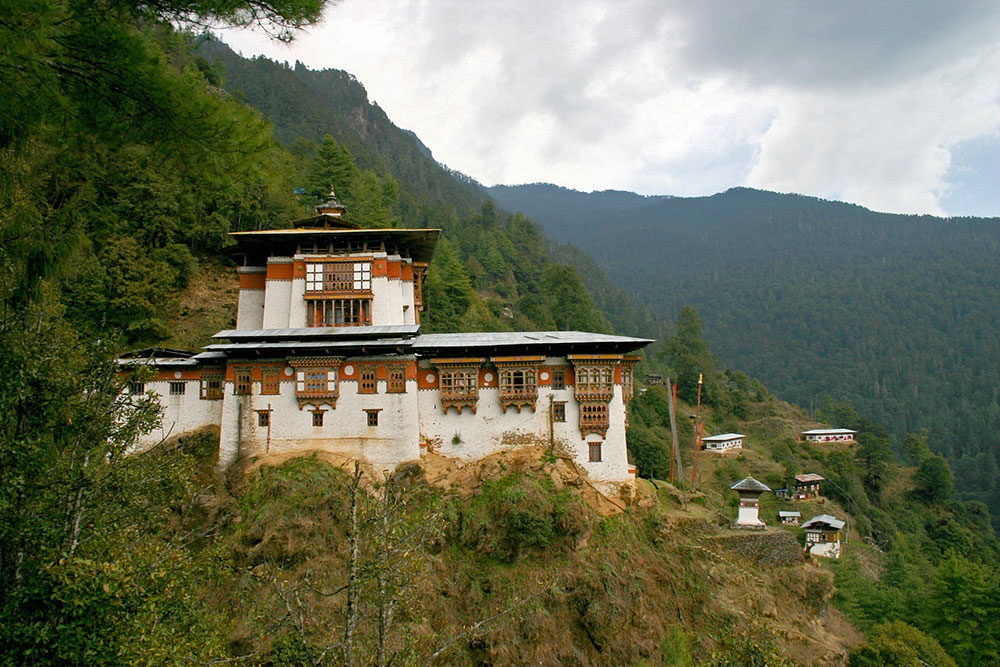The rescue efforts of Abu Simbel temple led by UNESCO was celebrated as an international groundbreaking project on September 22, 1968 when it was completed after four years of actual work of cutting and relocation of the sandstone monument.
Fifty-five years after this groundbreaking rescue operation of a UNESCO World Heritage, a similar story resonated in the tiny kingdom of Bhutan on 6 December 2023. As Her Majesty the Queen Mother Gyalyum Tshering Yangdoen Wangchuck and HRH the Gyalsey inaugurated the completion of reconstruction works of the 17th-century central tower of Tango monastery, Bhutan celebrated a peerless rescue of an intricate wall painting of this monument.
Tango Choing Phodrang (རྟ་མགོ་ཆོས་དབྱིངས་ཕོ་བྲང་) is a national heritage site for Bhutan, a national legacy of physical artifacts and an intangible attribute of our country. Built in 1688-89, its construction, the relics and mural paintings and their artists are well recorded in the biography of the commissioner of the temple, Gyelse Tenzin Rabgye (རྒྱལ་སྲས་བསྟན་འཛིན་རབ་རྒྱས 1638-1696), which makes the mural painting an exceptional artifact of age and history with surviving records.
The art of painting in these murals of Tango’s central tower was said to be of the Menlug (སྨན་ལུགས) tradition which originated from the 15th century artist Menthangpa Menla Dondrup (སྨན་ཐང་པ་སྨན་བླ་དོན་གྲུབ) who’s style and painting tradition was found to be popularly in practice during the rule of Phagdru ( ཕག་གྲུ) in Tibet. The distinction of this tradition is described as an artistic combination of the select best features of Newar and Chinese traditional painting traditions which he was said to have mastered. This gave rise to a new tradition of artistic production of his own, which is generally categorized as bright with lavish use of gold pigments, lively postures of the figures with excessive decorations and free natural elements which incorporated Chinese stylistic motifs in the background space.
While the traditional paintings have evolved with time and space, this particular production remains the earliest living mural painting of this tradition in Bhutan. This artistic mural evidence central to the history of the traditional art of painting in Bhutan would have otherwise now become a pictorial memory without the gallant rescue efforts devised by our people with technical expertise in the Department of Culture and Dzongkha Development (DCDD).
As a national heritage, the mural paintings embodied beyond the sociocultural and historical values in their artistic exclusivity of the time as a physical artifact, an attribute of intangible excellence. While the structural monument underwent a stylistic reconstruction in its original form and shape, dismantling the mural paintings to replace them with reproduction of its copies would have lost the artistic values and the attributes of the intangible excellence it embodies.
Different international experts were consulted in the process of building up to the idea of restoring the central tower which required dismantling of the old structure for reconstruction. As informed by the documentary on BBS, the consultations with foreign experts have not resulted in any concrete solutions and recommendations to help rescue the wall paintings because the mural was directly on the wall plastering of the temple without the use of canvas or the wooden panel for painting ground while the stone wall holding the murals has to be dismantled for structural reconstruction. The consultants did not have any known instances of how to rescue this kind of wall painting.
Despite the challenges of near impossible circumstances of rescuing this invaluable national treasure, without technical assistance from international experts. It is commendable of the collective efforts of every individual involved in this rescue project to have achieved this historical milestone in integrating trained professional expertise into an innovative invention of a new device in wall painting preservation.
Therefore, it is an inventive cultural rescue project, which not only saved national heritage at its original, but we now know it has an intellectual legacy of a conservation device first of its kind in the country, mustered from the combination of existing modern methods with local cultural knowledge. As informed by Mr Tashi Lhendup, the technical in-charge of the Tango wall painting rescue project a painting and textiles conservationist with the DCDD, it is a technique devised from the idea of wooden cover plates of traditional scriptures in the monasteries integrated with modern conservation methods and material to deal with such multifaceted conservation challenges in rescuing a painting on direct wall plastering.
Thus, it is an achievement worthy of a note in the history of cultural preservation, especially in the history of wall painting preservation, a historical achievement of the DCDD as a national body for cultural preservation and promotion.
Contributed by
Samten Yeshi


